- Home
- Deborah Harkness
The World of All Souls Page 42
The World of All Souls Read online
Page 42
DOUBLET: A man’s doublet made of black leather, quilted, with brass buttons down the front. Cut to fit close to the body, this doublet is minimally padded and sewn to accommodate someone with particularly broad shoulders, which would have been further accentuated by the deep-V construction and detailing of the garment. Removable sleeves are also black leather and close-fitting, with decorative brass buttons down their length. This particular garment was tailored for an unusually tall man. The leather is worn and fragile in parts.
Men’s Woolen Hose
HOSE: A pair of men’s woolen hose, remarkable for both their color (red) and their size (tall). The color is faded from age. These two long, footed tubes are fashioned from loosely woven fabric, cut on the bias to ensure a snug fit and thereby show the wearer’s legs to best advantage. Hose were fastened to breeches, a kind of short pants, with laces drawn through eyelets in the hose and breeches. Garters at the knee also helped hold the hose in place.
Background: From the late fourteenth century until 1700, many European men wore doublets. These were vests made of doubled-over fabric (hence the name) to which even more padding could be added, depending upon the fashion of the day. Doublets provided protection from the elements and at least some warmth. They also gave men a useful and discreet place to tuck small weapons and other valuables inside their clothing. This doublet is one of Matthew’s, as he favored the close-fitting style rather than the exaggerated padded stomach of the peascod doublets worn by others, including George Chapman. And these are the pair of red hose that Diana persuaded Matthew not to wear for his first audience with Emperor Rudolf. Both items were packed away in an attic of the Old Lodge and forgotten about until centuries later.
Man’s Linen Shirt (c. 1590)
Bishop House, Madison, New York, USA
Fine example of a man’s sixteenth-century English linen shirt with blackwork embroidery on the collar and cuffs. The handworked design of intricately detailed acorns and oak leaves, done with curving lines and shaded figures, is stitched with a single color (black) silk thread using the Holbein stitch, so that the design appears identically on both sides of the fabric.
Man’s Linen Shirt
Background: This is one of Matthew’s everyday shirts from 1590, and it is the one he was wearing when he and Diana timewalked back to the present. Blackwork embroidery, made with iron-blackened silk thread stitched on white linen or cotton, was an especially popular decorative technique in Elizabeth’s England. It was apt to show up on everything from smocks to women’s coifs (caps) and even cushion covers. As a fashionably dressed Elizabethan, Matthew had several shirts trimmed with blackwork. The style suited him well. The shadowed black of the tiny silk stitches on a crisp white linen background played beautifully against his white skin and his customary black doublet.
Novelty T-Shirts
Twenty-first Century
Sept-Tours, France
Graphic T-shirts still in a shipping envelope from a company called Get Shirty. A packing label indicates that the garments are woven of 100-percent ring-spun cotton. The tees are both V-neck and crew styles, in navy blue and black, women’s size XSMALL.
Background: These are some of Dr. Miriam Shephard’s favorite graphic tees. As an intellectual badass herself, Miriam does not suffer fools lightly. And she’s happy to let everyone know in advance.
Jewelry
Pilgrim’s Badge, Ampulla (c. 1150)
Pilgrim’s Badge
Private Collection
This tiny coffin is a pilgrim’s badge made of lead alloy (43 millimeters tall by 21 millimeters wide by 17 millimeters deep). Likely a keepsake from the tomb of Lazarus in the town of Bethany in the Holy Land, where Christians believe that Jesus Christ raised a man named Lazarus from the dead.
Background: From the twelfth century through to the early sixteenth, thousands of Catholic pilgrims traveled to Christian sites throughout Europe and the Holy Land, where enterprising local craftsmen sold small commemorative pilgrim’s badges. They came in a variety of styles, including ampullas, figures of saints, and other site-specific motifs. These inexpensive badges proved to be tremendously popular among the pilgrims. In some senses they were a kind of early tourist souvenir.
This Lazarus coffin is much like Matthew’s silver pilgrim’s badge from Bethany. He wore his badge around his neck for centuries as a reminder of Eleanor St. Leger, a woman he had fallen in love with when he lived in Jerusalem (near Bethany) during the twelfth century. Matthew never forgave himself for her death. After he fell in love with Diana, he sealed a drop of her blood alongside a drop of his own into the ampulla, which he then left behind at the farmhouse in Madison. The house magically and alchemically transformed the blood and mercury from the ampulla into a new creation, the blasted tree, and left the molten remains of Matthew’s small lead coffin embedded in its trunk.
Signet Ring (twelfth century)
Jewel Cabinet, Sept-Tours, France
Signet Ring
A gold signet ring with an engraved, semiprecious red carnelian set into a broad bezel. The red stone is engraved with an image of a man climbing out of a coffin and the words SECRETUM LAZARI encircling the image. The ring is heavy, at 12.2 grams, and has a large hoop, approximately size 21, suggesting that it was worn on the thumb. It might have belonged to a member of a relatively obscure medieval chivalric order, the Order of St. Lazarus, which finally disappeared during the late sixteenth century.
Background: For centuries signets have been employed in lieu of a unique signature (hence “signet”), because they contain unique, personal images carved into them. When pressed into wax or a similarly soft material, they leave behind a raised impression that serves as the signature of an individual or a member of an organization. Diana noticed Gallowglass and Hancock wearing a version of this particular ring when she first met them in Shadow of Night. It belonged to one of the Knights of Lazarus, the military order founded during the twelfth century and created by Philippe de Clermont to protect creatures and humans who could not protect themselves.
Silver and Gold Salamander Necklace (sixteenth century)
Silver and Gold Salamander Necklace
Benvenuto Cellini
Les Revenants, France
An exquisite necklace, approximately 24 inches, fashioned of miniature salamanders made of silver and gold with diamonds set in their backs. The salamanders are linked head to tail, and a large ruby pendant is attached to the necklace. Francis I commissioned the work from the Italian artist Benvenuto Cellini (1500–71), who was a goldsmith at his court. It is now in the de Clermont private collection.
Background: Francis I was a great patron of the arts and also an admirer of salamanders, which he’d chosen for his royal emblem due to their reputed ability to withstand deadly flames. The length of this necklace allowed the man or woman who wore it to maneuver it over the high collars and large ruffs worn by many at the time. Substantial pendants, like this ruby, were increasingly popular, in part because they were well suited for display on a woman’s exposed décolletage during a time when European—and particularly French—necklines were beginning to dip lower.
According to de Clermont family history, this was a gift from King Francis I (1494–1547) to Matthew de Clermont in recognition of services to the Crown. Matthew gave it to Diana when they were in Prague; he had Philippe send it to him there, along with the Bosch altarpiece. Diana was delighted by the craftsmanship of the tiny salamanders, and she also appreciated their alchemical symbolism, as salamanders were believed to have an affinity for fire. Diana wore the necklace to a dinner with the jealous and acquisitive Emperor Rudolf, inspiring him to give her a much more ostentatious chain containing the insignia of the Order of the Defeated Dragon.
Decorative Chain with Dragon Pendant (1400–50)
Decorative Chain with Dragon Pendant
> Jewel Cabinet, Sept-Tours, France
An elaborate collar-style necklace made of gold crosses linked together to form a chain, with a large circular pendant in the shape of a dragon with a flayed back and its tail wrapped around its neck. The dragon is green enameled glass over gold; the crosses are also gold, featuring red enamel and inlaid with emeralds, rubies, diamonds, and pearls. The jeweled crosses and dragon emblems are the insignia of the Order of the Defeated Dragon, a chivalric order founded by Sigismund, king of Hungary.
Background: Emperor Rudolf gave this garish necklace to Diana in a misguided attempt to win her affections, explaining that it was a beloved family heirloom that had belonged to his grandmother. Matthew and Gallowglass revealed privately to Diana that the flayed dragon and crosses represented the Order of the Defeated Dragon, or the Drăculeşti, and that the order was the enemy of the de Clermonts. On returning to England, Diana offered the necklace to Queen Elizabeth, who was irked with Matthew and Diana’s failure to bring Edward Kelley and his philosopher’s stone back from Prague. The queen readily accepted the collar from Diana under the guise that it was a gift from Emperor Rudolf to Elizabeth. Before her death in 1603, Elizabeth sent the collar back to Philippe de Clermont with a note reading, “Time catches us all.” The note is preserved in the de Clermont archives.
Pearl Earring (c. 1500)
Pearl Dangle Earrings
French
The Old Lodge, Woodstock, England
A dangle earring, made in an unusually simple setting of twisted and plaited fine gold wires. A lustrous baroque, or teardrop-shaped, natural pearl (approximately 29–30 millimeters) hangs from the gold filigree of the earring.
Background: This is from a pair of Ysabeau’s earrings. Matthew and Diana found one of them inside Bridget Bishop’s poppet in the farmhouse in Madison, and Diana used it, along with the silver chess piece and Matthew’s copy of Doctor Faustus, to guide them back to Elizabethan England. There Françoise located the earring’s mate in a wooden box at the Old Lodge.
Diana formed a strong attachment to these earrings, which served as a tangible link between the past and present, and she even wore them when she and Matthew met Queen Elizabeth at Richmond Palace. When Diana encountered the young witch Rebecca White in front of the Hart and Crown, Diana recognized her as one of her Bishop grandmothers. She gave her one of the earrings, asking her to guard it. Rebecca did as she was asked, keeping it safe and passing it down to her daughter, who passed it on to her daughter, until Bridget Bishop enclosed it in a poppet and put a strong spell on it for safekeeping. Eventually it was entrusted to the Bishop house in Madison until Diana, the timewalker, had need of it. Diana left the other earring at the sixteenth-century Old Lodge, where it has now been found at the bottom of a box of trinkets.
Gimmal Wedding Ring (sixteenth century)
Gimmal Wedding Ring
Private Collection
A gimmal, or twinned, ring from sixteenth-century France, this ring is made of three gold hoops that fit together to form a single ring. Each hoop of this traditional wedding ring is inscribed with a short love poem in Old French: A MA VIE DE COER ENTIER (my whole heart for my whole life), MON DEBUT ET MA FIN (my beginning and my end) with the symbols alpha and omega, and SE SOUVENIR DU PASSE, ET QU’IL YA AVENIR (remember the past, and that there is a future). Each of the two outside hoops bears a tiny, exquisitely detailed hand, complete with wrist and shirt cuff and with tiny diamonds decorating the cuffs, while the center hoop contains an enameled heart, inset with a polished octahedral, or pointed-cut, diamond. When the three hoops are fitted together, the two hands clasp the heart between them.
Background: Ysabeau called this her scribble ring because she used the sharp point of the octahedral diamond to write on glass. It had been a gift from Philippe to Ysabeau, and she sent it to the farmhouse in Madison for Matthew to give to Diana. Matthew gave it to her as a token of their marriage, and Diana wore it when they timewalked back to the sixteenth century. Philippe was shocked to see it on Diana’s hand, but it served its purpose of conveying Ysabeau’s trust in her. It also revealed to Philippe his death, because he knew that Ysabeau would not have given away his love token while he was alive.
The Victoria and Albert Museum in London has a similar marriage gimmal ring in its collection, perhaps made by the same unknown goldsmith but dated slightly later, c. 1600–1650.
Golden Arrowhead (date unknown)
Golden Arrowhead
Present Location Unknown
An arrowhead made of gold. Unknown artist. Unknown age; ancient. Shows considerable wearing on the barbs, though the tip is quite sharp. Perhaps intended to be worn, as it has an attachment for wearing as a pendant or brooch.
Background: Philippe gave Diana a gold arrowhead for a wedding gift in 1590, and she made a habit of wearing it on a chain around her neck. The arrowhead was slightly worn and quite old even then, but still lethal. At the Old Lodge, the goddess fired this arrowhead on a silver shaft into Diana’s body, and it came to rest painlessly along her spine. At Chelm, Diana drew the arrow from her back and killed Benjamin, saving Matthew. And after Benjamin’s death, the goddess directed Philippe to return the golden arrow with the silver shaft to Diana; there it remains, lodged in her back until the next time she has need of an arrow that no creature can outrun.
Rope of Pearls (date unknown)
Rope of Pearls
Les Revenants, France
Long rope necklace of matched, natural pearls on linen thread. No clasp. Rope length: 157 centimeters long, approximately .5 centimeter wide. Origins unknown.
Background: This rope of pearls was another gift from Philippe to Diana on her wedding at Sept-Tours, along with the broom necklace and the gold arrowhead. After she and Matthew timewalked home to the present, Alain gave the pearls back to her, having kept them safe through the centuries. Unlike some of the other jewelry she wore in Elizabethan England, these pearls were as fashionable in the present as they were in the sixteenth century.
Necklace with Emblems of the Order of the Broom/Angevins (c. 1400)
Les Revenants, France
Necklace with Emblems of the Order of the Broom
Heavy, wide chain of linked gold flowers inlaid with precious gems. This fine necklace was likely worn by a Plantagenet king or someone who enjoyed royal favor, as some of the flowers, inset with yellow diamonds, are modeled after the common broom plant, Planta genista, which was taken by the royal English family, the House of Plantagenet, as their emblem. The broom flowers alternate with fleurs-de-lis made of gold and outlined in sapphires. This necklace was probably designed to be worn in the manner of a mantle, resting upon the shoulders. There is a slim gold chain from which a pendant could be hung. Length: 83.6 centimeters. Width: 5.8 centimeters.
Background: This was Philippe’s chain, given to him by one of the Plantagenet kings, who ruled England from 1154 to 1485. Philippe then gave it to Diana as a wedding gift in 1590. Originally a cross hung from the chain, but Philippe replaced this with the gold arrowhead, thinking it more fitting for Diana. When Diana was dressing to meet Queen Elizabeth, Mary Sidney took the necklace apart and used one of the broom blossoms as a brooch, stringing Diana’s rope of pearls from it. On formal occasions it was usual for Englishwomen to wear several necklaces of varying lengths and types at the same time, and it was also common practice for ladies to dismember their jewelry and use it variously for brooches, pendants, and even as hair decorations.
Jeweled Hair Clips (c. 1590)
Jeweled Hair Clips
Les Revenants, France
A set of five matching silver hair decorations, each in the shape of a crescent moon and inlaid with milky white cabochon opals. They have small wire hooks on the reverse side that grasp the hair and hold the jewelry securely in place. French. Approximately 1.8 centimeters by .8 cen
timeters.
Background: These tiny jeweled moons were another wedding gift from Philippe to Diana. It was then the style for European women to wear jeweled finery in their hair, particularly on formal occasions, and the moon symbol and silver metal were perfect for Diana, as they held particular alchemical and magical significance for her.
Gold Crown (c. ninth century, with later additions)
Gallery, Sept-Tours, France
Gold Crown
Magnificent gold crown with later repairs and additions inset with precious and semiprecious gems. While we know nothing of the history of this crown, it has a sizable number of scratches, chips, and dents—evidence that it was worn frequently by the monarch(s) to whom it has belonged, and over many centuries. Its base is a simple circlet of four curved, rectangular, jeweled plates. Four large jeweled fleurs-de-lis were added to these four original plates. An uncut, roughly spherical “pigeon’s blood” red ruby, estimated to weigh in excess of 180 carats (36 grams), is mounted at the centerpiece of the circlet. In the ancient world, rubies were esteemed above all other precious gems for both their rarity and their color, which was associated with blood and power.
Background: This belonged to Philippe de Clermont, who treated it with alarming nonchalance. He stored it atop a statue of a Greek god in his hallway at Sept-Tours and lent it out for Thomas, the young servant, to wear when he was crowned the Lord of Misrule during Saturnalia. The design is strikingly similar to the Crown of Charlemagne, the name of the ancient coronation crown for kings of the Franks and later kings of France.

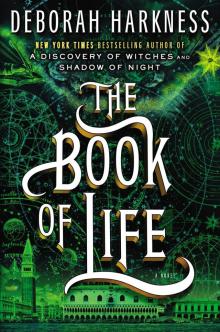 The Book of Life
The Book of Life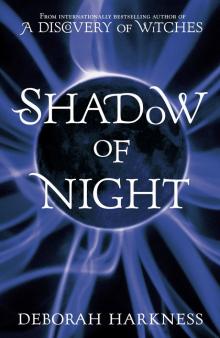 Shadow of Night
Shadow of Night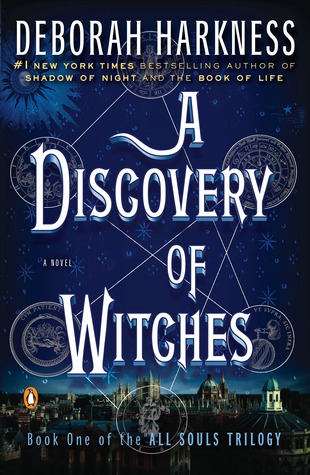 A Discovery of Witches
A Discovery of Witches The All Souls Real-Time Reading Companion
The All Souls Real-Time Reading Companion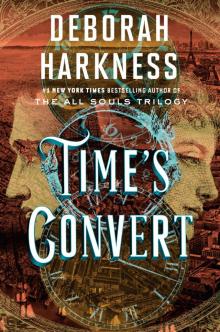 Time's Convert
Time's Convert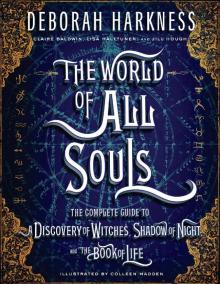 The World of All Souls
The World of All Souls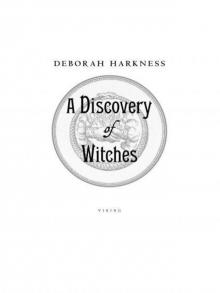 A Discovery of Witches: A Novel (All Souls Trilogy)
A Discovery of Witches: A Novel (All Souls Trilogy) Shadow of Night: A Novel
Shadow of Night: A Novel